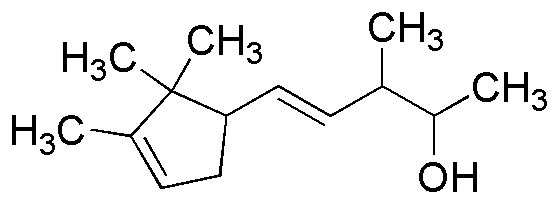3-Methyl-5-(2,2,3-trimethyl-3-cyclopenten-1-yl)-4-penten-2-ol is widely utilized in research focused on:
- Flavor and Fragrance Industry: This compound is used as a flavoring agent in food products and as a fragrance component in perfumes, providing a unique scent profile that enhances consumer appeal.
- Aromatherapy: Its pleasant aroma makes it suitable for use in essential oils, promoting relaxation and well-being in therapeutic applications.
- Cosmetic Formulations: The compound is incorporated into skincare and cosmetic products for its fragrance and potential skin-conditioning properties, adding value to beauty products.
- Research and Development: In academic and industrial research, it serves as a building block for synthesizing other complex organic compounds, facilitating advancements in organic chemistry.
- Natural Product Synthesis: It plays a role in the synthesis of natural products, contributing to the development of new drugs and bioactive compounds in pharmaceuticals.
General Information
Properties
Safety and Regulations
Applications
3-Methyl-5-(2,2,3-trimethyl-3-cyclopenten-1-yl)-4-penten-2-ol is widely utilized in research focused on:
- Flavor and Fragrance Industry: This compound is used as a flavoring agent in food products and as a fragrance component in perfumes, providing a unique scent profile that enhances consumer appeal.
- Aromatherapy: Its pleasant aroma makes it suitable for use in essential oils, promoting relaxation and well-being in therapeutic applications.
- Cosmetic Formulations: The compound is incorporated into skincare and cosmetic products for its fragrance and potential skin-conditioning properties, adding value to beauty products.
- Research and Development: In academic and industrial research, it serves as a building block for synthesizing other complex organic compounds, facilitating advancements in organic chemistry.
- Natural Product Synthesis: It plays a role in the synthesis of natural products, contributing to the development of new drugs and bioactive compounds in pharmaceuticals.
Documents
Safety Data Sheets (SDS)
The SDS provides comprehensive safety information on handling, storage, and disposal of the product.
Product Specification (PS)
The PS provides a comprehensive breakdown of the product’s properties, including chemical composition, physical state, purity, and storage requirements. It also details acceptable quality ranges and the product's intended applications.
Certificates of Analysis (COA)
Search for Certificates of Analysis (COA) by entering the products Lot Number. Lot and Batch Numbers can be found on a product’s label following the words ‘Lot’ or ‘Batch’.
*Catalog Number
*Lot Number
Certificates Of Origin (COO)
This COO confirms the country where the product was manufactured, and also details the materials and components used in it and whether it is derived from natural, synthetic, or other specific sources. This certificate may be required for customs, trade, and regulatory compliance.
*Catalog Number
*Lot Number
Safety Data Sheets (SDS)
The SDS provides comprehensive safety information on handling, storage, and disposal of the product.
DownloadProduct Specification (PS)
The PS provides a comprehensive breakdown of the product’s properties, including chemical composition, physical state, purity, and storage requirements. It also details acceptable quality ranges and the product's intended applications.
DownloadCertificates of Analysis (COA)
Search for Certificates of Analysis (COA) by entering the products Lot Number. Lot and Batch Numbers can be found on a product’s label following the words ‘Lot’ or ‘Batch’.
*Catalog Number
*Lot Number
Certificates Of Origin (COO)
This COO confirms the country where the product was manufactured, and also details the materials and components used in it and whether it is derived from natural, synthetic, or other specific sources. This certificate may be required for customs, trade, and regulatory compliance.

